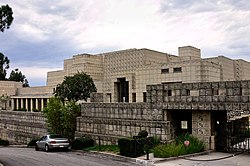Ennis House
|
Ennis House
|
|
 |
|
| Location | 2607 Glendower Ave Los Angeles, California |
|---|---|
| Coordinates | 34°6′58.40″N 118°17′34.44″W / 34.1162222°N 118.2929000°WCoordinates: 34°6′58.40″N 118°17′34.44″W / 34.1162222°N 118.2929000°W |
| Built | 1924 |
| Architect | Frank Lloyd Wright |
| Architectural style | Mayan Revival, Textile Block |
| NRHP Reference # | 71000145 |
| CHISL # | 1011 |
| LAHCM # | 149 |
| Significant dates | |
| Added to NRHP | October 14, 1971 |
| Designated LAHCM | March 3, 1976 |
The Ennis House is a residential dwelling in the Los Feliz neighborhood of Los Angeles, California, United States, south of Griffith Park. The home was designed by Frank Lloyd Wright for Charles and Mabel Ennis in 1923 and was built in 1924.
Following La Miniatura in Pasadena, and the Storer and Freeman Houses in the Hollywood Hills of Los Angeles, the structure is the fourth and largest of Wright's textile block designs, constructed primarily of interlocking pre-cast concrete blocks, in the northern Los Angeles area.
The design is based on ancient Mayan temples, and along with other buildings by Frank Lloyd Wright, such as the A. D. German Warehouse in Wisconsin and Aline Barnsdall Hollyhock House in Hollywood, the Ennis House is sometimes referred to as an example of the Mayan Revival architecture. Its prominent detail is the relief ornamentation on its textile blocks, inspired by the symmetrical reliefs of Mayan buildings in Uxmal.
The Ennis House is a designated city, state, and national landmark. It is currently owned by billionaire Ronald Burkle.
Costs escalated owing to difficulties developed during construction, which was supervised by Frank Lloyd Wright's son Lloyd Wright. The owners took over after the superstructure reached the windows and carried out various changes, deviating from Wright's original design.
...
Wikipedia



